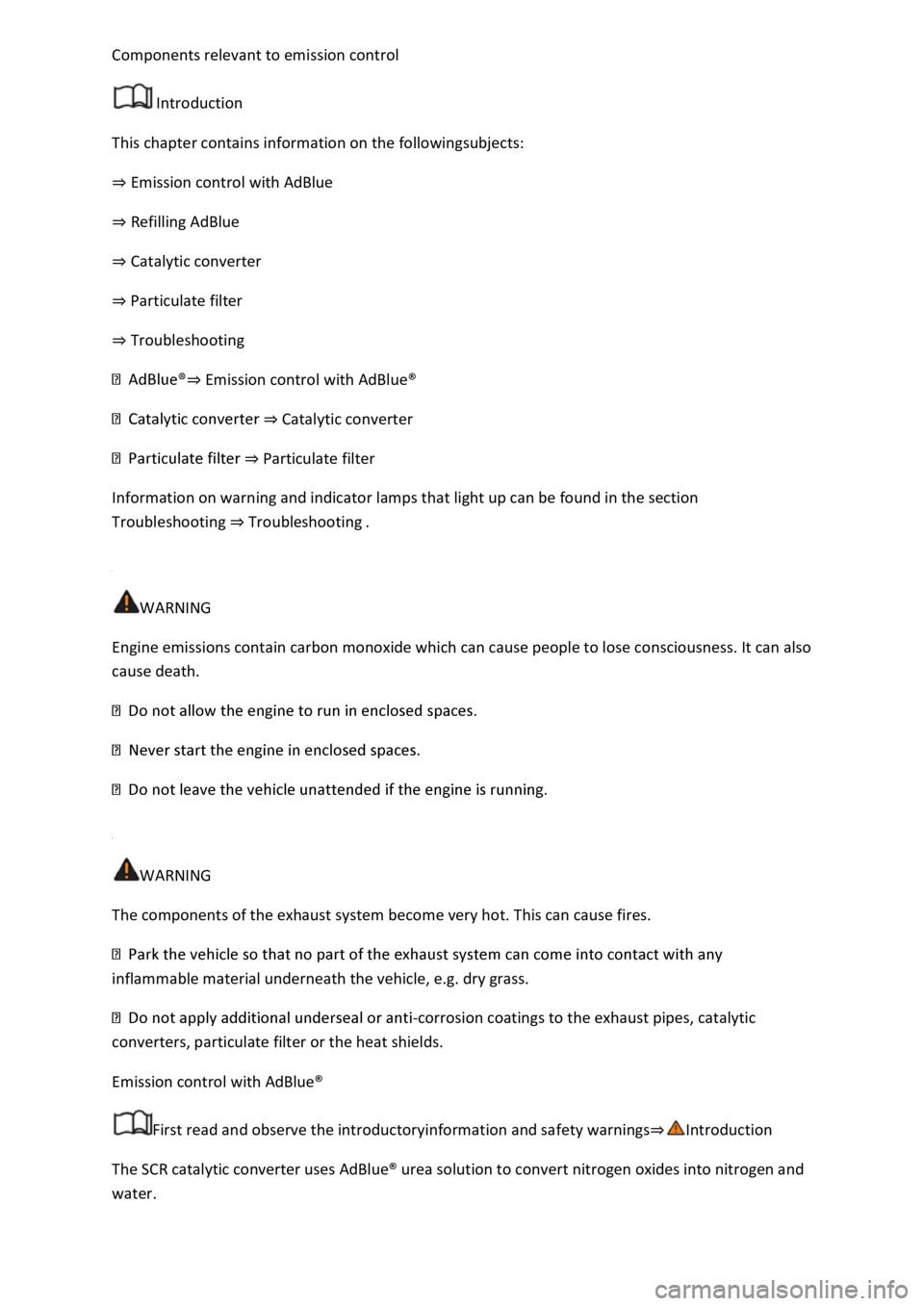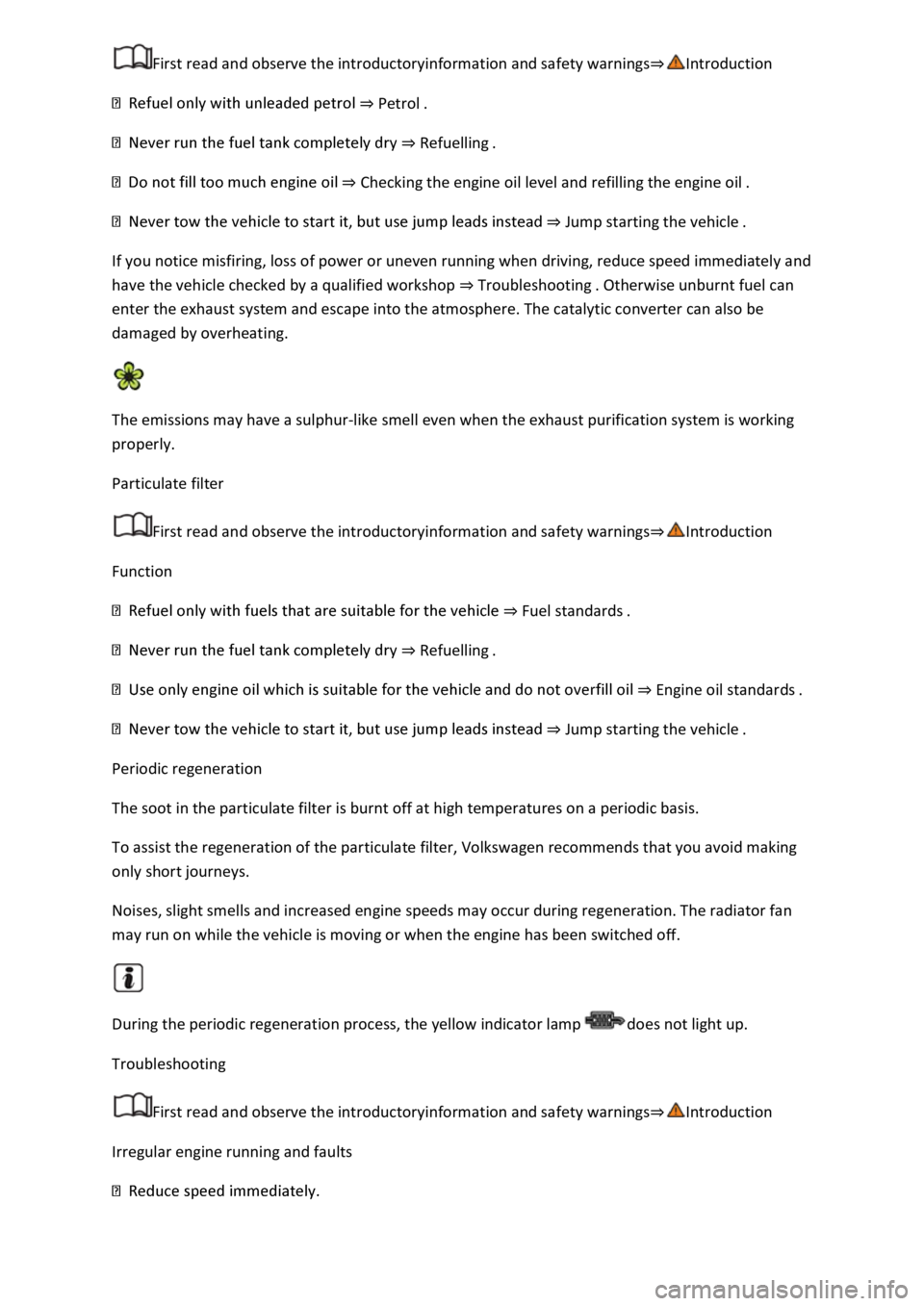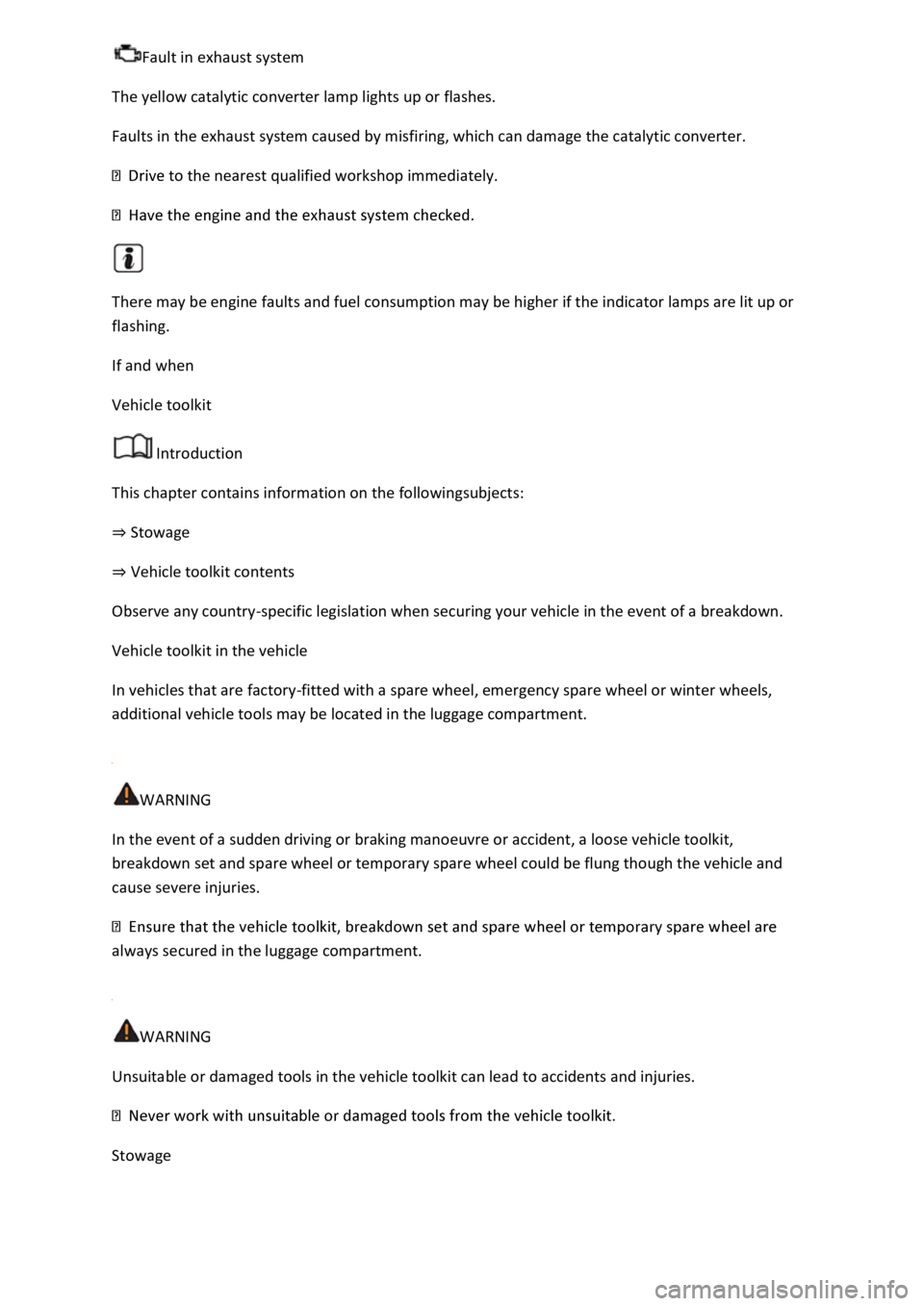2019 VOLKSWAGEN T-ROC catalytic converter
[x] Cancel search: catalytic converterPage 33 of 502

RNING
Driving when the fuel level is too low can lead to the vehicle coming to a standstill in traffic,
potentially causing accidents and serious injuries.
When the fuel level is too low, the fuel supply to the engine could be irregular, especially when
driving up or down hills and inclines.
The steering, all driver assist systems and brake support systems stop working if the engine sputters
or goes off due to fuel shortage or irregular fuel supply.
Always fill the tank when it is still 1/4 full. This reduces the risk of running out of fuel and breaking
down.
NOTICE
Do not run the tank empty. The irregular fuel supply can cause misfiring and allow unburnt fuel to
enter the exhaust system. The catalytic converter or particulate filter could be damaged as a result.
The small arrow next to the petrol pump symbol in the fuel gauge shows you the side of the vehicle
on which the tank flap is located.
Coolant temperature display
Fig. 17 Coolant temperature display in the analogue instrument cluster.
Page 185 of 502

has been selected. The vehicle could move suddenly or something unexpected may happen that may
cause damage, fire and serious injuries.
Never use a start booster. Start boosters could explode and cause the engine to suddenly run at high
revs.
WARNING
Never leave the engine running if you leave the vehicle unattended, particularly if a gear or position
has been selected. The vehicle could move suddenly or something unexpected may happen that may
cause damage, fire or serious injuries.
WARNING
Start boosters could explode or cause the engine to suddenly run at high revs.
Never use a start booster.
NOTICE
The starter and the engine can be damaged if you attempt to start the engine while the vehicle is in
motion or if the engine is started again immediately after it has been switched off.
When the engine is cold, avoid high engine speeds, driving at full throttle and overloading the
engine.
Do not push start or tow start the vehicle. Unburnt fuel could damage the catalytic converter.
NOTICE
If the engine does not start, never use the starter with a gear selected and the vehicle key in the
ignition lock in position Fig.
0for driving or tow-starting, e.g. when the fuel tank is empty.
This could cause damage to the starter.
Fill up with fuel if necessary Fuel types and refuellingor jump start the vehicle Jump starting
If the engine does not start, seek expert assistance.
Do not warm up the engine by running it while the vehicle is stationary. Instead, pull off as soon as
there is good visibility through the windows. This helps the engine reach operating temperature
faster and reduces emissions.
Page 187 of 502

The brake servo will not work when the engine is switched off. More force is required on the brake
pedal to stop the vehicle.
If the vehicle key is removed from the ignition, the steering lock may activate and you will no longer
be able to steer the vehicle.
WARNING
The components of the exhaust system become very hot. This can cause fires and serious injuries.
Never park the vehicle so that parts of the exhaust system can come into contact with any
inflammable material underneath the vehicle, e.g. undergrowth, leaves, dry grass, spilt fuel etc.
Never apply additional underseal or anti-corrosion coatings to the exhaust pipes, catalytic
converters, heat shields or particulate filter.
NOTICE
If the vehicle has been driven at high load for a long period, the engine can overheat when it is
switched off. In order to avoid damage to the engine, allow the engine to run in neutral position for
approximately 2 minutes before switching it off.
After the engine is switched off, the radiator fan in the engine compartment may run on for some
minutes, even if the ignition is switched off or the vehicle key has been removed. The radiator fan
will switch itself off automatically.
Electronic immobiliser
The immobiliser helps to prevent the engine from being started and driven with an unauthorised
vehicle key.
There is a chip in the vehicle key. The immobiliser is automatically deactivated by this when a valid
vehicle key is inserted in the ignition lock.
The electronic immobiliser is automatically activated when the vehicle key is removed from the
ignition lock. In vehicles with Keyless Access, the vehicle key must be outside the vehicle.
The engine can be started only using a Volkswagen Genuine vehicle key with the correct code.
Coded vehicle keys are available from a Volkswagen dealership.
Problem-free operation of the vehicle is guaranteed only with Volkswagen Genuine vehicle keys.
Troubleshooting
Page 327 of 502

Introduction
This chapter contains information on the followingsubjects:
Emission control with AdBlue
Refilling AdBlue
Catalytic converter
Particulate filter
Troubleshooting
Emission control with AdBlue
Catalytic converter
Particulate filter
Information on warning and indicator lamps that light up can be found in the section
Troubleshooting Troubleshooting
WARNING
Engine emissions contain carbon monoxide which can cause people to lose consciousness. It can also
cause death.
WARNING
The components of the exhaust system become very hot. This can cause fires.
inflammable material underneath the vehicle, e.g. dry grass.
-corrosion coatings to the exhaust pipes, catalytic
converters, particulate filter or the heat shields.
Emission control with AdBlue
Page 331 of 502

Petrol
Refuelling
Checking the engine oil level and refilling the engine oil
Jump starting the vehicle
If you notice misfiring, loss of power or uneven running when driving, reduce speed immediately and
have the vehicle checked by a qualified workshop Troubleshooting
enter the exhaust system and escape into the atmosphere. The catalytic converter can also be
damaged by overheating.
The emissions may have a sulphur-like smell even when the exhaust purification system is working
properly.
Particulate filter
First read and observe the introductoryinformation and safety warnings
Function
Fuel standards
Refuelling
Engine oil sta
Jump starting the vehicle
Periodic regeneration
The soot in the particulate filter is burnt off at high temperatures on a periodic basis.
To assist the regeneration of the particulate filter, Volkswagen recommends that you avoid making
only short journeys.
Noises, slight smells and increased engine speeds may occur during regeneration. The radiator fan
may run on while the vehicle is moving or when the engine has been switched off.
During the periodic regeneration process, the yellow indicator lamp does not light up.
Troubleshooting
First read and observe the introductoryinformation and safety warnings
Irregular engine running and faults
Page 333 of 502

The yellow catalytic converter lamp lights up or flashes.
Faults in the exhaust system caused by misfiring, which can damage the catalytic converter.
to the nearest qualified workshop immediately.
There may be engine faults and fuel consumption may be higher if the indicator lamps are lit up or
flashing.
If and when
Vehicle toolkit
Introduction
This chapter contains information on the followingsubjects:
Stowage
Vehicle toolkit contents
Observe any country-specific legislation when securing your vehicle in the event of a breakdown.
Vehicle toolkit in the vehicle
In vehicles that are factory-fitted with a spare wheel, emergency spare wheel or winter wheels,
additional vehicle tools may be located in the luggage compartment.
WARNING
In the event of a sudden driving or braking manoeuvre or accident, a loose vehicle toolkit,
breakdown set and spare wheel or temporary spare wheel could be flung though the vehicle and
cause severe injuries.
always secured in the luggage compartment.
WARNING
Unsuitable or damaged tools in the vehicle toolkit can lead to accidents and injuries.
Stowage
Page 358 of 502

e tow-started. Attempt to start the engine by jump
starting Jump starting
Vehicles with a manual gearbox:
Tow-starting is generally not recommended. If the engine does not start, first attempt to start the
engine by jump starting Jump startingease note that the maximum tow-starting distance for
petrol engines is 50 m.
-rope or the tow-bar only to the towing eyes provided Fitting the rear towing
eyeor Fitting the front towing eye
warning lights.
utral to prevent
driving into the towing vehicle.
NOTICE
When tow-starting, unburnt fuel can enter the catalytic converter and damage it.
Towing
First read and observe the introductoryinformation and safety warnings
Preparations
h the tow-rope or the tow-bar only to the towing eyes provided Fitting the rear towing
eyeor Fitting the front towing eyeor to the towing bracket Trailer towing
-rope is not twisted. Otherwise a towing eye may become unscrewed
during towing.
regulations to the contrary.
Pulling vehicle (front)
tow-rope must be taut before you drive off properly.
Page 376 of 502

engine oil to flow into the sump up to the marking on the engine oil dipstick.
Read the engine oil level from the dipstick again before refilling with a further small quantity of
engine oil. Never overfill engine oil .
After refilling, the engine oil level should be in the middle of area
area nd must not be in area .
If too much engine oil has been added unintentionally and the engine oil level is in area
start the engine. Inform a qualified workshop and seek expert assistance if necessary.
Close the engine oil filler opening with the cap after filling.
Insert the oil dipstick into the guide tube as far as it will go. If there is a marking on the upper end of
the oil dipstick, this marking must fit into the corresponding groove at the top end of the guide tube
upon insertion.
Close the bonnet In the engine compartment.
WARNING
Engine oil can ignite if it comes into contact with hot engine components. It can cause fires, burns
and other serious injuries.
up and ignite when the engine is running.
dipstick is properly inserted back into the guide tube. This will prevent the engine oil from draining
out on to hot engine components when the engine is running.
NOTICE
Fig. 186
necessary. The catalytic converter and the engine could otherwise be damaged.